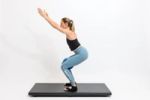Treating and preventing pelvic floor dysfunction is only one thing these expert-backed moves can do.
When thinking about areas of your body to strengthen, your pelvic floor muscles likely aren’t the first to come to mind — but they probably should. After all, these down-under muscles not only are instrumental in maintaining continence (think: the ability to control bowel movements and urination) but also provide support and stability for your core muscles, says Rebecca Nelken, MD, a urogynecologist and ob-gyn on the board of KindBody.
Beyond the more obvious physical functions, your pelvic floor muscles — which sit at the base of your pelvis — have a connection to your mind, too. “The pelvic floor muscles can be susceptible to a lot of subconscious stress, but by awakening the neuromuscular connection from the brain to the actual muscles of the pelvic floor, you open up to this amazing kind of superpower, which can completely transform the body,” explains Lauren Roxburgh, a board-certified structural integration practitioner and founder of The Aligned Life Studio.
Why Should You Do Pelvic Floor Exercises
There’s a lot going on in the pelvic region: connective tissues, muscles, organs, energy. Since everything is interconnected “when you work with the pelvic floor, you also benefit so many other areas of the body,” Roxburgh explains.
“Once you release the pelvic floor, the benefits are pretty profound,” she adds, noting that many people experience a greater range of motion in the hips, a release in the lower back, a softer jaw or even relief from digestive issues. And research backs this up: A 2009 study suggests that jaw tension — specifically, temporomandibular joint (TMJ) dysfunction — is strongly connected to hip mobility. Plus, studies link pelvic floor dysfunction with digestive disorders, such as irritable bowel syndrome.
Another benefit? More expansive breath. "The pelvic floor is incredibly important for actual proper breathing," says Roxburgh. "As we breathe, our diaphragm pushes down into our organs and our organs push down into our pelvic floor, which actually opens and expands like a flower."
RELATED: 3 Breathing Exercises for Restful Sleep
While more subtle, an equally profound shift can occur in your body’s energetic flow. "In Kundalini, they talk a lot about the energy in our pelvic floor (called the 'serpentine energy'), which is not just sexual energy, but the energy of connection, charisma and creativity," she explains. "When we open up that energy, it moves through the spinal cord all the way to the head, aligning the body."
How to Do Pelvic Floor Exercises
"Because there’s not a lot of mobility within the pelvis, mobilizing the pelvic floor muscles takes a little bit of finessing," says Laura Wilson, a Pilates instructor and founder of Natural Pilates.
The first step? "Understanding the difference between controlling the inside muscles versus the outside muscles (or the deep vs. superficial muscles)," per Wilson. One way to do this is to think of pulling up and lengthening out. "The muscles at the bottom of the pelvis between the sitbones, pubic bone and tailbone can be thought of as an elevator, moving up and down from the bottom of the prop [the ball] toward the belly button," she explains.
Once you know how to control the different types of muscles down there, you'll be better equipped to do Pilates-inspired pelvic floor exercises to strengthen your nether region. Overtime, practicing these moves can not only help you develop an even better understanding of how these muscles work together and with your core, but also strengthen your pelvic floor muscles (thereby helping prevent or treat any pelvic floor dysfunction).
RELATED: Symptoms of Pelvic Floor Dysfunction Everyone Should Know
Below, Wilson shares her five favorite pelvic floor exercises to strengthen and lengthen those down-there muscles. But first, a quick tip, per Wilson: Add a mini stability ball (aka Pilates ball) to help work the muscles more deeply and add support.
5 Pelvic Floor Exercises to Try

PHOTO CREDIT: Attila Luhasz
1. Bridge with the Ball
How to:
- Lie on your back with feet close to your hips and ball between your knees.
- Inhale and then exhale, flatting your back before rolling your spine off of the mat into bridge position.
- Inhale and hold at the top for a long second.
- Maintaining bridge position, exhale and use your inner thighs to squeeze the ball 5-10 times. Exhale deeply with each squeeze and activate the pelvic floor.
- Inhale and hold at the top for a long second.
- Exhale and slowly articulate your spine back down to the mat, one vertebra at a time while relaxing the pelvic floor.
Repeat 5x. Be sure not to arch your spine at the top of the bridge. You should feel your glutes, not your lower back.

PHOTO CREDIT: Attila Luhasz
2. Half Roll Back with Ball
How to:
- Start seated tall on your sit bones, ball between your knees. If your lower back is rounded, sit on a cushion. Reach your arms forward or place them on your knees or backs of the thighs.
- Inhale.
- Exhale. Keeping your feet flat, tuck your pelvis under and roll halfway down to the mat. Squeeze the ball once when you reach the end range.
- Inhale and return to start position
Repeat 10-20x with a single squeeze or add progressive squeezes each time you roll back to increase the challenge on the abs, inner thighs and pelvic floor.

PHOTO CREDIT: Attila Luhasz
3. Leg Taps
How to:
- Start by lying on your back with your spine flat and legs in tabletop position with a 90-degree bend at hips and knees.
- Inhale. Keeping your knee bent at a 90-degree angle, lower one foot towards the mat.
- Exhale. Using your abs, pull the leg back up to tabletop. Remember to keep your back flat and only go as low in the range of motion as your spine stays flat.
Repeat 10x each side. Then do another set of 10, lowering both legs together. To increase the challenge, perform the same sequence with straight legs or with the ball under your tailbone, which can test your balance and stretch the lower back.

PHOTO CREDIT: Attila Luhasz
4. Side Bends on the Ball
How to:
- Lie on your side with the ball under your rib cage. (For more support, bring the ball closer to your rib cage; for more of a challenge, move the ball closer to your pelvis.)
- Bend your bottom leg at a 90-degree angle and keep the top leg strait in line with your body. Hands can go behind your head or across your chest.
- Inhale.
- Exhale. Side bend, squeezing your top rib toward your hip
- Inhale. Lengthen back to start position
Repeat 10-20x. This exercise has a small range of motion. Keep your bottom ribs heavy on the ball as you do a small side crunch.

PHOTO CREDIT: Attila Luhasz
5. Squats with the Ball
How to:
- Start standing with legs hip- or shoulder-distance apart and ball between your upper inner thighs.
- Inhale.
- Exhale. Bend your knees, only as low as your back stays straight.
- Inhale. Return vertical, squeezing the ball as you lengthen
Repeat 10-20x. Think of sending your tailbone back and chest forward. Bring your weight back toward your heels as you squat, then to the mid-foot as you stand.




